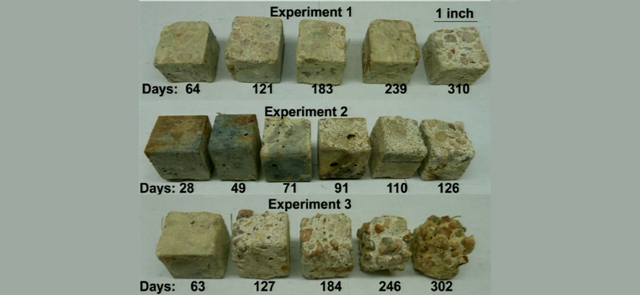Underground in places nobody likes to look, bacteria are doing terrible things to our sewage pipes. The concrete pipes that carry our waste are literally dissolving away, forcing engineers into a messy, expensive battle against tiny microbes.
“The veins of our cities are in serious trouble, and they’re in serious trouble because of corrosion, and this corrosion has been unanticipated and it’s accelerating,” said Mark Hernandez at a symposium on the microbiology of the built environment in Washington DC yesterday. Hernandez is a civil engineer, but he’s meeting with microbiologists because this problem is bacterial. Essentially, it’s an infection of the nation’s sewage system.
The sewer as a microbial ecosystem
Here’s what’s going on. One set of microbes emits hydrogen sulfide, the gas that is also responsible for raw sewage’s unpleasant smell. This gas fills the empty space between the top of the pipe and the water flow. Another set of microbes living in this headspace turns hydrogen sulfide to sulfuric acid, which eats away at concrete, leaving behind gypsum, the powdery stuff you find in drywall.
“Essentially what we’re ending up with is wet drywall,” said Hernandez. This is one reason the American Society of Civil Engineers has gave our wastewater infrastructure a D grade.
The current solution is to put plastic liners into the concrete pipes, a process that is almost as expensive as digging them up entirely. But if the problem is microbial, perhaps the solution is, too?

Photo of concrete cubes placed in sewage pipes via Mark Hernandez
When Hernandez and his team sequenced bacteria living in the headspace of different pipes, they found only three or four species — an extremely remarkable lack of diversity. With so few actual problematic microbes, there could be a way justto target them specifically with some type of antibiotic or even bacteria-infecting viruses.
The solution they settled on was shotcrete — a type of concrete that can be sprayed onto the inside of pipes — embedded with small amounts of charcoal and bacteria-killing metals like chrome. As the acid ate through this concrete, metal would be released. Based on Hernandez’s tests, this concrete did hold up better against sewage microbes — suggesting a promising solution to corrosion.
Designing water pipes for — rather than against — bacteria
But gatherings of microbiologists can be funny things these days. With the technological ability to sequence bacterial samples from every table top, belly button, and shoe, we’ve come to understand that everything is covered in millions of bacteria — mostly unknown, mostly benign, some even beneficial. Instead of just trying to kill the few harmful ones, perhaps we can build environments that encourage the growth of others, which then keep out the bad ones — an ecological and architecture version of prebiotics.
That was the premise of a talk at the same symposium by Amy Pruden, a professor of civili engineering at Virginia Tech. If sewers are the veins of our cities, than drinking water pipes are the arteries. Pruden talked about how the very design of our drinking water system could be prebiotic to encourage the growth of good microbes and discourage the ones that cause disease. There are, after all, an estimated rely on those microbes to treat out sewage . Sewage treatment plants? They’re basically a series of tanks that let bacteria do the work of breaking down our waste. In laying down miles of water pipes, we’ve created an entire microbial ecosystem under our feet.
Top image: AP Photo/Mary Altaffer
